延边朝鲜族英语介绍
延边介绍英文版

长吉图是吉林省长春市、吉林市 部分区域和图们江的简称,区域 面积和人口均占吉林省的1/3,经 济总量占1/2强,是中国参与图们 江区域合作开发的核心地区和重 要支撑
。
It has the area of 42,700 square kilometers and a population of nearly 2.2 million people. Currently, the han nationality of the population accounts for more than half, 59%, Korean accounte for 39% remaining
延边介绍英文版
location
Jilin Province
Yanbian
The capital is Yanji(延吉)city
I have lived in Yanji for 10 years,I mis(朝鲜族)
Yanbian Korean Autonomous Prefecture 鲜族自治州)
自治州的面积有42,700平方公里、人口约220万 人。现时自治州全部人口当中,汉族占超过半 数以上,达59%;朝鲜族另占余下39%
cloth
food
house
speciality
Changbai mountain
The Changjitu includs Changchun, Jilin and Tumen area, the population occupies Jilin Province 1/3, the economic output occupies 1/2, is China participates in the Tumen Jiang region cooperation development the core area and the important support.
朝鲜族简介英文版ppt汇总

• Chaoxian are mainly distributed in northeast China's Jilin, Liaoning and
Heilongjiang provinces, a few scattered in Inner Mongolia and some mainland cities. Population of 1,923,800 (2000 census). China's Korean migration from the seventeenth century, when the Korean peninsula over. • Chaoxian-populated areas, especially in the comprehensive development of Yanbian, agriculture, forestry, animal husbandry, and fishery production. Yanbian area is the famous hometown of rice in northern China, is one of China's major producing flue-cured tobacco. Yanbian cattle is one of China's five local varieties of cattle, ginseng, deer • Velvet were famous.
• At most, made four sloping, more common practice is to spread straw curtain in the rafters or willow branches, above wiping mud.Then covered with 30-50 cm thick straw, and finally with rope woven mesh, the entire roof package live, or overlap with straws drill phase will be covered with a roof, in case the wind blows the straw blown.Leabharlann istory and culture
Module 5 Book 7 Writing-介绍我国朝鲜族
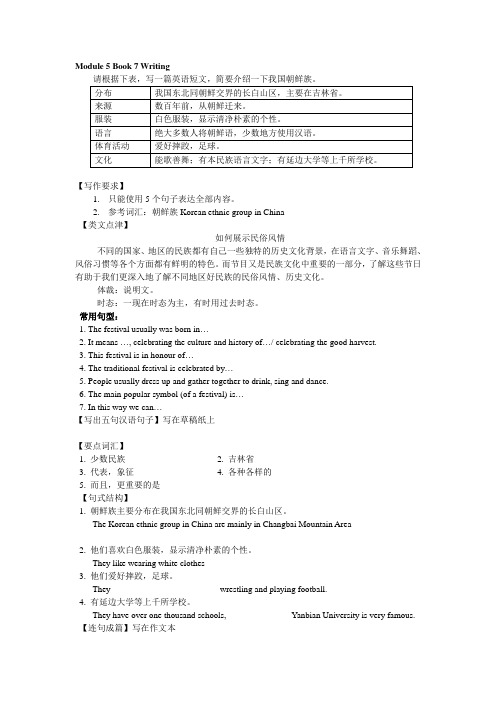
Module 5 Book 7 Writing请根据下表,写一篇英语短文,简要介绍一下我国朝鲜族。
【写作要求】1.只能使用5个句子表达全部内容。
2.参考词汇:朝鲜族Korean ethnic group in China【类文点津】如何展示民俗风情不同的国家、地区的民族都有自己一些独特的历史文化背景,在语言文字、音乐舞蹈、风俗习惯等各个方面都有鲜明的特色。
而节目又是民族文化中重要的一部分,了解这些节日有助于我们更深入地了解不同地区好民族的民俗风情、历史文化。
体裁:说明文。
时态:一现在时态为主,有时用过去时态。
常用句型:1. The festival usually was born in…2. It means …, celebrating the culture and history of…/ celebrating the good harvest.3. This festival is in honour of…4. The traditional festival is celebrated by…5. People usually dress up and gather together to drink, sing and dance.6. The main popular symbol (of a festival) is…7. In this way we can…【写出五句汉语句子】写在草稿纸上【要点词汇】1. 少数民族_________________2. 吉林省__________________3. 代表,象征_______________4. 各种各样的____________________5. 而且,更重要的是_____________________________【句式结构】1. 朝鲜族主要分布在我国东北同朝鲜交界的长白山区。
The Korean ethnic group in China are mainly in Changbai Mountain Area _______________ ______________________________________________________2. 他们喜欢白色服装,显示清净朴素的个性。
朝鲜族纯英文介绍_带水印
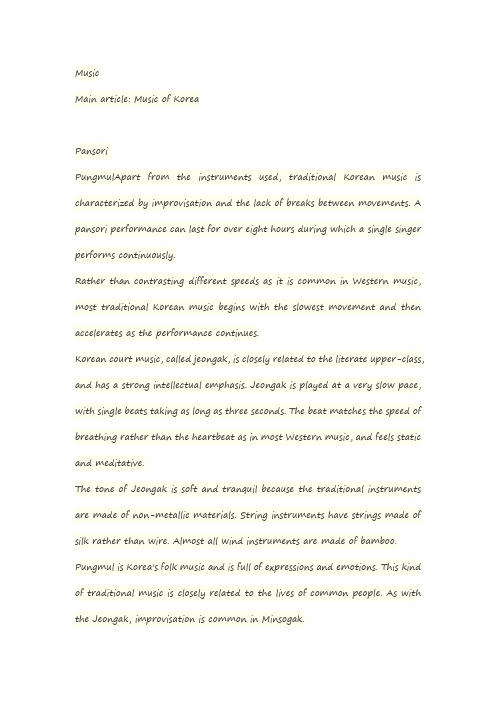
MusicMain article: Music of KoreaPansoriPungmulApart from the instruments used, traditional Korean music is characterized by improvisation and the lack of breaks between movements. A pansori performance can last for over eight hours during which a single singer performs continuously.Rather than contrasting different speeds as it is common in Western music, most traditional Korean music begins with the slowest movement and then accelerates as the performance continues.Korean court music, called jeongak, is closely related to the literate upper-class, and has a strong intellectual emphasis. Jeongak is played at a very slow pace, with single beats taking as long as three seconds. The beat matches the speed of breathing rather than the heartbeat as in most Western music, and feels static and meditative.The tone of Jeongak is soft and tranquil because the traditional instruments are made of non-metallic materials. String instruments have strings made of silk rather than wire. Almost all wind instruments are made of bamboo. Pungmul is Korea's folk music and is full of expressions and emotions. This kind of traditional music is closely related to the lives of common people. As with the Jeongak, improvisation is common in Minsogak.Traditional Korean musical instruments can be divided into wind, string, and percussion types. Wind instruments include the piri (cylindrical oboe), taepyeongso (metal-bell shawm), daegeumsaenghwang (mouth organ) and the hun (ocarina). Traditional string instruments include zithers such as the gayageum, geomungo, and ajaeng, and the haegeum, a two-stringed fiddle.A great number of traditional percussion instruments are used including the kkwaenggwari (hand-held gong), the jing (hanging gong), buk (barrel drum), janggu, (hourglass drum), bak (clapper), and pyeonjong (bell chimes or stone chimes), as well as the eo (tiger-shaped scraper) and the chuk (wooden box).Main article: Korean danceJinju geommuAs with music, there is a distinction between court dances and folk dances. Common court dances are jeongjaemu performed at banquets, and ilmu, performed at Confucian rituals. Jeongjaemu is divided into native dances (hyangak jeongjae) and forms imported from China (dangak jeongjae). Ilmu are divided into civil dance (munmu) and military dance (mumu). Religious dances include all the performances at shamanistic rites (gut). Secular dances include both group dances and individual performances. Traditional choreography of court dances is reflected in many contemporary productions.Main article: Korean paintingA scenery on Dano dayThe earliest paintings found on the Korean peninsula are petroglyphs of prehistoric times. With the arrival of Buddhism from China, different techniques were introduced. These techniques quickly established themselves as the mainstream techniques, but indigenous techniques still survived.There is a tendency towards naturalism with subjects such as realistic landscapes, flowers and birds being particularly popular. Ink is the most common material used, and it is painted on mulberry paper or silk.In the 18th century indigenous techniques were advanced, particularly in calligraphy and seal engraving.Arts are both influenced by tradition and realism in North Korea. For example, Han’s near-photographic "Break Time at the Ironworks" shows muscular men dripping with sweat and drinking water from tin cups at a sweltering foundry. Son’s "Peak Chonnyo of Mount Kumgang" is a classical Korean landscape of towering cliffs shrouded by mists (source : "The New York Times", [5]. Sisters Duk Soon Fwhang and Chung Soon Fwang O'Dwyer who fled to the United States in the late 1950s avoid overtly political statements, and render seemingly benign subjects of nature—flowers, birds, fields, insects, mountains—as tempestuous and emotionally charged zones of conflict.Lacquer drawer with mother-of-pearl inlay, at the National Museum of Korea in Seoul.There is a unique set of handicrafts produced in Korea. Most of the handicrafts are created for a particular everyday use, often giving priority to the practical use rather than aesthetics. Traditionally, metal, wood, fabric, lacquerware, and earthenware were the main materials used, but later glass, leather or paper have sporadically been used.Ancient handicrafts, such as red and black pottery, share similarities with pottery of Chinese cultures along the Yellow River. The relics found of the Bronze Age, however, are distinctive and more elaborate.Many sophisticated and elaborate handicrafts have been excavated, including gilt crowns, patterned pottery, pots or ornaments. During the Goryeo period the use of bronze was advanced. Brass, that is copper with one third zinc, has been a particularly popular material. The dynasty, however, is renowned for its use of celadon ware.During the Joseon period popular handicrafts were made of porcelain and decorated with blue painting. Woodcraft was also advanced during that period. This led to more sophisticated pieces of furniture, including wardrobes, chests, tables or drawers.Main article: Korean pottery and porcelainA celadon incense burner from the Goryeo Dynasty with Korean kingfisher glaze.The use of earthenware on the Korean peninsula goes back to the Neolithic. The history of Korean Ceramics is long and includes both Korean pottery a later development after the traditional use of coils and hammered clay to create early votive and sculptural artifacts. During the Three Kingdoms period, pottery was advanced in Silla. The pottery was fired using a deoxidizing flame, which caused the distinctive blue grey celadon color. The surface was embossed with various geometrical patterns.In the Goryeo period jade green celadon ware became more popular. In the 12th century sophisticated methods of inlaying were invented, allowing more elaborate decorations in different colours.White porcelain became popular in the 15th century. It soon overtook celadon ware. White porcelain was commonly painted or decorated with copper. With the Japanese invasions of Korea in the 16th century, many potters were kidnapped to Japan where they profoundly influenced Japanese ceramics.[4] [5] [6] Many leading Japanese pottery families today can trace their art and ancestry to these Korean potters whom the Japanese kidnapped by the thousands, such as during the Japanese Assault on Korea of 1592.[6][7][8] In the mid Joseon period (late 17th century) blue-and-white porcelainbecame popular. Designs were painted in cobalt blue on white porcelain. With the growth of Japan's hegemony on the peninsula towards the end of the 19th century the tradition of porcelain largely declined in favour of Japanese imports. However, the fact that Japan's relocating whole cities of Korean potters by force to boost pottery culture in Japan annuls the misconception that the Japanese pottery culture flourished at the time.HomesMain article: Korean architectureTraditional house, hanokTraditional farmer's house; Folk Village, SeoulSites of residence are traditionally selected using geomancy. It is believed that any topographical configuration generates invisible forces of good or ill (gi). The negative and positive energies (yin and yang) must be brought into balance.A house should be built against a hill and face south to receive as much sunlight as possible. This orientation is still preferred in modern Korea. Geomancy also influences the shape of the building, the direction it faces and the material it is built of.Traditional Korean houses can be structured into an inner wing (anchae) and an outer wing (sarangchae). The individual layout largely depends on the region and the wealth of the family. Whereas aristocrats used the outer wing for receptions, poorer people kept cattle in the sarangchae. The wealthier a family, the larger the house. However, it was forbidden to any family except for the king to have a residence of more than 99 kan. A kan is the distance between two pillars used in traditional houses.The inner wing normally consisted of a living room, a kitchen and a wooden-floored central hall. More rooms may be attached to this. Poorerfarmers would not have any outer wing. Floor heating (ondol) has been used in Korea for centuries. The main building materials are wood, clay, tile, stone, and thatch. Because wood and clay were the most common materials used in the past not many old buildings have survived into present times. Japan's kidnapping of an entire city known for its castle building skills built Japan's most famous castles and palaces, an act which the Japanese government has formally accepted and apologized for.But now days, people live in apartments and more modernized houses.GardensMain article: Korean gardenHyangwonjeong, a garden in Gyeongbokgung, SeoulThe principles of temple gardens and private gardens are the same. They generally resemble gardens in China, and the Japanese in turn adopted a similar garden layout from Korea. Part of the reason is because gardening in East Asia is heavily influenced by Taoism. Taoism emphasizes nature and mystery, paying great attention to the details of the layout. In contrast to Japanese and Chinese gardens which fill a garden with man made elements, traditional Korean gardens avoid artificialities, trying to make a garden more natural than nature.The lotus pond is an important feature in the Korean garden. If there is a natural stream, often a pavilion is built next to it, allowing the pleasure of watching the water. Terraced flower beds are a common feature in traditional Korean gardens.The Poseokjeong site near Gyeongju was built in the Silla period. It highlights the importance of water in traditional Korean gardens. The garden of Poseokjeong features an abalone-shaped watercourse. During the last days of the Silla kingdom, the king's guests would sit along the watercourse and chat while wine cups were floated during banquets.DressMain article: HanbokHanbokHwarot, bridal robeSee also List of Korean clothing. The traditional dress known as hanbok (한복, 韩服) (known as joseonot in the DPRK) has been worn since ancient times. The hanbok consists of a shirt (jeogori) and pants (baji). The traditional hat is called gwanmo and special meaning is attached to this piece of clothing.According to social status, Koreans used to dress differently, making clothing an important mark of social rank. Impressive, but sometimes cumbersome, costumes were worn by the ruling class and the royal family. Jewelry was also used to distance themselves from the ordinary people. Traditional jewelry for women was a pendant shaped in the shape of certain elements of nature made of precious gems stones, to which a tassel of silk was connected. Common people were often restricted to un-dyed plain clothes. This everyday dress underwent relatively few changes during the Joseon period. The basic everyday dress was shared by everyone, but distinctions were drawn in official and ceremonial clothes.During the winter people wore cotton-wadded dresses. Fur was also common. Because ordinary people normally wore pure white undyed materials, the people were sometimes referred to as the white-clad people.Hanbok are classified according to their purposes: everyday dress, ceremonial dress and special dress. Ceremonial dresses are worn on formal occasions, including a child's first birthday (doljanchi), a wedding or a funeral. Special dresses are made for purposes such as shamans, officials.Today the hanbok is still worn during formal occasions. The everyday use of the dress, however, has been lost. However, elderly still dress in hanbok as well as active estates of the remnant of aristocratic families from the Chosun Dynasty.。
介绍延吉的英语作文
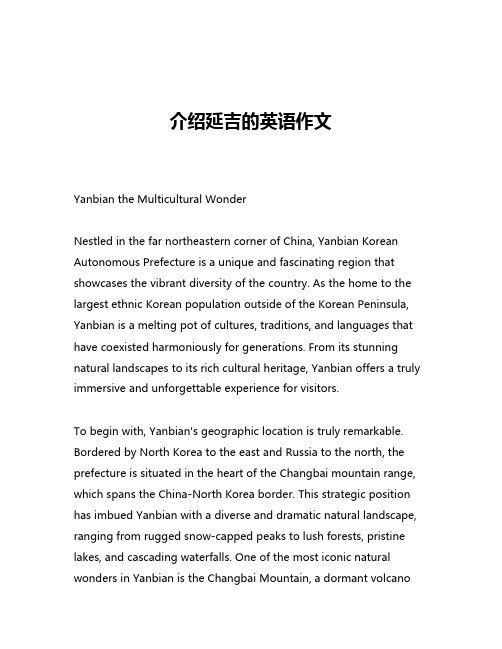
介绍延吉的英语作文Yanbian the Multicultural WonderNestled in the far northeastern corner of China, Yanbian Korean Autonomous Prefecture is a unique and fascinating region that showcases the vibrant diversity of the country. As the home to the largest ethnic Korean population outside of the Korean Peninsula, Yanbian is a melting pot of cultures, traditions, and languages that have coexisted harmoniously for generations. From its stunning natural landscapes to its rich cultural heritage, Yanbian offers a truly immersive and unforgettable experience for visitors.To begin with, Yanbian's geographic location is truly remarkable. Bordered by North Korea to the east and Russia to the north, the prefecture is situated in the heart of the Changbai mountain range, which spans the China-North Korea border. This strategic position has imbued Yanbian with a diverse and dramatic natural landscape, ranging from rugged snow-capped peaks to lush forests, pristine lakes, and cascading waterfalls. One of the most iconic natural wonders in Yanbian is the Changbai Mountain, a dormant volcanothat boasts the deepest crater lake in China. The lake, known as Tianchi or the "Heavenly Lake," is a stunning turquoise-hued body of water that reflects the surrounding peaks and forests in its still, mirror-like surface.Beyond its natural beauty, Yanbian is renowned for its vibrant cultural mosaic. As the home to the largest ethnic Korean population in China, the region is a hub of Korean language, cuisine, and traditions. The Korean influence is evident in everything from the traditional Korean-style architecture of the cities to the ubiquitous Korean barbecue restaurants and karaoke bars. Visitors can immerse themselves in the unique blend of Chinese and Korean culture by exploring the region's numerous historical sites, such as the ancient Koguryo tombs, or by attending lively festivals and celebrations that showcase the rich heritage of the Korean ethnic minority.One of the most captivating aspects of Yanbian's cultural landscape is the harmonious coexistence of diverse ethnic groups. In addition to the dominant Korean population, the region is home to a significant Han Chinese community, as well as smaller numbers of Manchu, Hui, and other ethnic minorities. This cultural diversity is reflected in the region's architecture, cuisine, and traditions, creating a truly unique and dynamic environment. Visitors can explore the bustling markets of Yanbian's cities, where vendors from different ethnic backgrounds sell a wide array of goods, from traditionalKorean handicrafts to Chinese herbal medicines and Russian-influenced culinary delights.The region's multilingual environment is another fascinating aspect of Yanbian's cultural tapestry. While Mandarin Chinese is the official language, Korean is widely spoken and used in daily life, and many residents also have a strong command of Russian, the legacy of Yanbian's proximity to the former Soviet Union. This linguistic diversity adds to the region's charm and complexity, offering visitors the opportunity to immerse themselves in a truly multilingual experience.Yanbian's cultural richness is also evident in its vibrant arts and entertainment scene. The region is home to a thriving performing arts community, with numerous theaters, dance troupes, and musical ensembles that showcase the traditional and contemporary artistic expressions of the Korean and other ethnic minorities. Visitors can attend lively performances of traditional Korean folk dances, watch skilled acrobats and martial artists, or enjoy the soulful melodies of Korean pop music.In addition to its cultural attractions, Yanbian also offers a wealth of opportunities for outdoor enthusiasts. The region's rugged mountains, dense forests, and pristine lakes provide ample opportunities for hiking, camping, and wildlife watching. Visitors canexplore the Changbai Mountain National Nature Reserve, a UNESCO World Heritage site that is home to a diverse array of flora and fauna, including the iconic Siberian tiger and the rare Amur leopard. Alternatively, they can venture to the region's many picturesque lakes, such as Tianchi and Jingbo Lake, and enjoy the serene beauty of the natural landscapes.Overall, Yanbian is a truly unique and captivating destination that offers a rich and immersive cultural experience for visitors. From its stunning natural landscapes to its vibrant multicultural heritage, the region is a testament to the incredible diversity and resilience of the Chinese nation. Whether you are drawn to the region's history, its culinary delights, or its outdoor adventures, Yanbian is sure to leave a lasting impression and inspire a deeper appreciation for the incredible tapestry of cultures that make up this remarkable cornerof the world.。
向别人介绍自己的家乡延吉英语作文
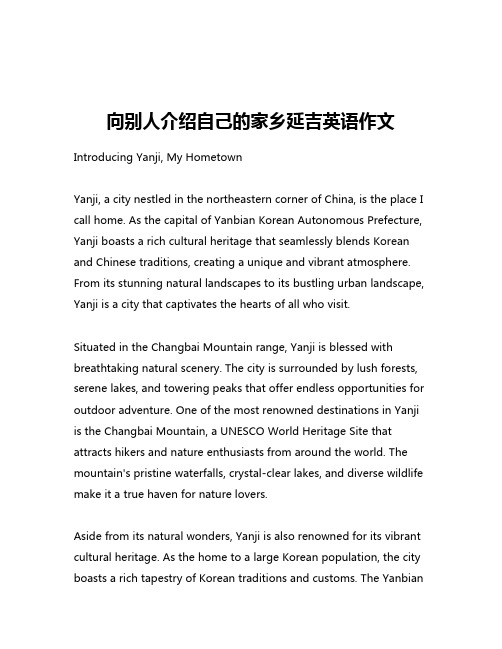
向别人介绍自己的家乡延吉英语作文Introducing Yanji, My HometownYanji, a city nestled in the northeastern corner of China, is the place I call home. As the capital of Yanbian Korean Autonomous Prefecture, Yanji boasts a rich cultural heritage that seamlessly blends Korean and Chinese traditions, creating a unique and vibrant atmosphere. From its stunning natural landscapes to its bustling urban landscape, Yanji is a city that captivates the hearts of all who visit.Situated in the Changbai Mountain range, Yanji is blessed with breathtaking natural scenery. The city is surrounded by lush forests, serene lakes, and towering peaks that offer endless opportunities for outdoor adventure. One of the most renowned destinations in Yanji is the Changbai Mountain, a UNESCO World Heritage Site that attracts hikers and nature enthusiasts from around the world. The mountain's pristine waterfalls, crystal-clear lakes, and diverse wildlife make it a true haven for nature lovers.Aside from its natural wonders, Yanji is also renowned for its vibrant cultural heritage. As the home to a large Korean population, the city boasts a rich tapestry of Korean traditions and customs. The YanbianKorean Autonomous Prefecture, of which Yanji is the capital, was established in 1952 to preserve the unique cultural identity of the Korean minority in China. This legacy is visible in the city's architecture, cuisine, and festivals, creating a fascinating blend of Korean and Chinese influences.One of the most iconic landmarks in Yanji is the Beishan Park, a sprawling green space that serves as the cultural heart of the city. The park is home to the Yanji Korean Folk Museum, where visitors can immerse themselves in the history and traditions of the Korean community. The museum's exhibits showcase traditional Korean costumes, musical instruments, and handicrafts, offering a glimpse into the rich cultural heritage of the region.The culinary scene in Yanji is another highlight for visitors. As a city with a significant Korean population, Yanji is renowned for its delectable Korean cuisine, from the fragrant kimchi to the hearty Korean barbecue. Visitors can explore the city's bustling street food markets, where they can indulge in a wide variety of authentic Korean dishes, as well as savor the fusion of Korean and Chinese flavors that have emerged in the region.Yanji's vibrant cultural life is further enhanced by its numerous festivals and events. One of the most anticipated events is the Yanbian Korean Autonomous Prefecture International Folk ArtFestival, which showcases the diverse performing arts and cultural traditions of the region. The festival features traditional Korean music and dance performances, as well as showcases of local crafts and culinary delights. This annual celebration serves as a testament to the enduring spirit of the Korean community in Yanji and the broader Yanbian region.Beyond its cultural richness, Yanji is also a hub of economic and technological development. The city is home to several prominent universities and research institutions, making it a center of innovation and education. The city's strategic location, near the borders of North Korea and Russia, also positions it as an important hub for international trade and commerce, with a thriving industrial and commercial sector.Despite its rapid development, Yanji has managed to preserve its charming small-town feel. The city's winding streets, lined with traditional Korean-style buildings and bustling local markets, offer a sense of authenticity and community that is often lacking in larger urban centers. Visitors can easily immerse themselves in the local way of life, whether it's strolling through the picturesque Beishan Park, indulging in a delicious Korean meal, or engaging in lively conversations with the friendly locals.In conclusion, Yanji is a city that seamlessly blends the best ofChinese and Korean cultures, offering a truly unique and unforgettable experience for all who visit. From its stunning natural landscapes to its vibrant cultural heritage, Yanji is a city that truly encapsulates the essence of the Yanbian region, making it a must-visit destination for anyone seeking to explore the rich diversity of China.。
延边美食介绍英语作文
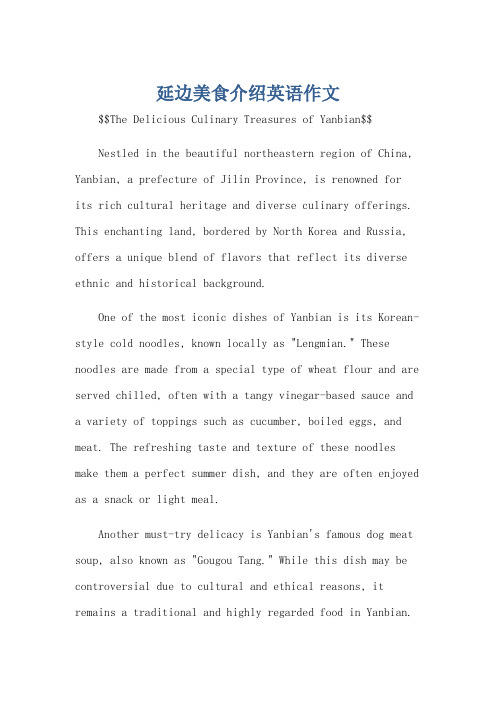
延边美食介绍英语作文$$The Delicious Culinary Treasures of Yanbian$$Nestled in the beautiful northeastern region of China, Yanbian, a prefecture of Jilin Province, is renowned forits rich cultural heritage and diverse culinary offerings. This enchanting land, bordered by North Korea and Russia, offers a unique blend of flavors that reflect its diverse ethnic and historical background.One of the most iconic dishes of Yanbian is its Korean-style cold noodles, known locally as "Lengmian." These noodles are made from a special type of wheat flour and are served chilled, often with a tangy vinegar-based sauce and a variety of toppings such as cucumber, boiled eggs, and meat. The refreshing taste and texture of these noodles make them a perfect summer dish, and they are often enjoyed as a snack or light meal.Another must-try delicacy is Yanbian's famous dog meat soup, also known as "Gougou Tang." While this dish may be controversial due to cultural and ethical reasons, it remains a traditional and highly regarded food in Yanbian.The dog meat is usually stewed with various herbs and spices, resulting in a rich and flavorful broth that is believed to have medicinal properties.For seafood lovers, Yanbian offers an array of freshwater fish dishes. The region's rivers and lakes provide an abundance of fish species, which are often prepared in a variety of ways, including steaming, frying, and stewing. The fish are known for their tender textureand sweet flavor, making them a prized delicacy in Yanbian cuisine.In addition to these signature dishes, Yanbian also boasts a wide range of traditional Chinese dishes with a distinct local flavor. For instance, the region's dumplings, known as "Jiaozi," are a popular dish that is often served during festivals and special occasions. These dumplings can be filled with a variety of meats and vegetables, and are often accompanied by a spicy vinegar-based dipping sauce.Moreover, Yanbian's cuisine also incorporatesinfluences from its neighboring countries. For example, its Russian-style pies, known as "Pie," are a popular snackthat features a flaky crust filled with a variety of meats,fruits, or vegetables. These pies are often enjoyed as an afternoon snack or as part of a larger meal.The presentation of Yanbian's cuisine is also noteworthy. Dishes are often served in elaborate and colorful arrangements, with each ingredient carefully chosen and prepared to enhance the overall flavor andvisual appeal of the meal. This attention to detailreflects the region's deep respect for its culinary traditions and its commitment to preserving them for future generations.In conclusion, the culinary offerings of Yanbian are a diverse and delicious blend of traditional Chinese, Korean, and Russian flavors. From its iconic cold noodles and dog meat soup to its variety of seafood and traditional dishes, Yanbian's cuisine offers a unique and unforgettable dining experience. Whether you're a foodie looking to explore new flavors or simply someone who enjoys good food, Yanbian is sure to satisfy your culinary curiosity.。
关于爱丽丝延边的小作文用英文写
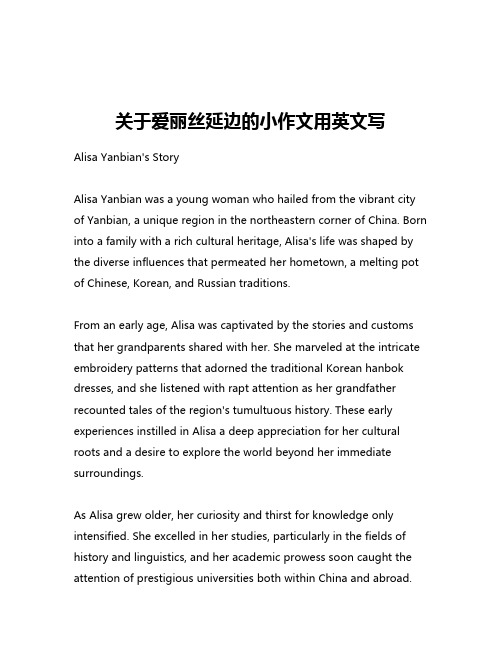
关于爱丽丝延边的小作文用英文写Alisa Yanbian's StoryAlisa Yanbian was a young woman who hailed from the vibrant city of Yanbian, a unique region in the northeastern corner of China. Born into a family with a rich cultural heritage, Alisa's life was shaped by the diverse influences that permeated her hometown, a melting pot of Chinese, Korean, and Russian traditions.From an early age, Alisa was captivated by the stories and customs that her grandparents shared with her. She marveled at the intricate embroidery patterns that adorned the traditional Korean hanbok dresses, and she listened with rapt attention as her grandfather recounted tales of the region's tumultuous history. These early experiences instilled in Alisa a deep appreciation for her cultural roots and a desire to explore the world beyond her immediate surroundings.As Alisa grew older, her curiosity and thirst for knowledge only intensified. She excelled in her studies, particularly in the fields of history and linguistics, and her academic prowess soon caught the attention of prestigious universities both within China and abroad.After much deliberation, Alisa decided to pursue her higher education in the United States, where she could immerse herself in a diverse and dynamic academic environment.During her time in the US, Alisa not only honed her academic skills but also delved deeper into the exploration of her own cultural identity. She joined student organizations that celebrated the diversity of Asian and Pacific Islander communities, and she actively participated in cultural exchange programs that allowed her to share the richness of Yanbian's heritage with her peers.One of Alisa's most cherished experiences during this period was her involvement in a student-led project that aimed to preserve the endangered Yanbian dialect of the Korean language. Working alongside linguists and community elders, Alisa conducted field research, collected oral histories, and developed educational resources to ensure that this unique linguistic treasure would not be lost to future generations.As Alisa's academic journey progressed, she began to envision a future where she could combine her scholarly pursuits with her passion for cultural preservation and exchange. Upon completing her studies, she was offered a prestigious position at a leading think tank, where she could leverage her expertise and network to promote greater understanding and collaboration between China and theinternational community.In her new role, Alisa became a tireless advocate for the Yanbian region, sharing its rich history, vibrant culture, and unique challenges with policymakers, scholars, and the general public. She organized cultural festivals, facilitated academic exchanges, and worked tirelessly to secure funding and resources for community-based initiatives that aimed to revitalize the region's linguistic and artistic traditions.Through her unwavering dedication and her ability to bridge cultural divides, Alisa quickly became a respected and influential figure in the international arena. Her work not only brought greater recognition to the Yanbian region but also inspired others to embrace the value of cultural diversity and the importance of preserving the world's rich tapestry of traditions.As Alisa's career continued to flourish, she never forgot her roots or the lessons she had learned from her grandparents and the elders of her community. She remained deeply connected to Yanbian, visiting her family regularly and maintaining strong ties with the local organizations and initiatives she had helped to establish.In many ways, Alisa's story is a testament to the power of cultural identity and the transformative potential of education and cross-cultural exchange. Through her unwavering dedication and her ability to bridge the gap between her local roots and the global stage, Alisa has become a shining example of how individuals can make a profound impact on the world by embracing their unique cultural heritage and using it as a springboard for positive change.。
写延边的英文作文
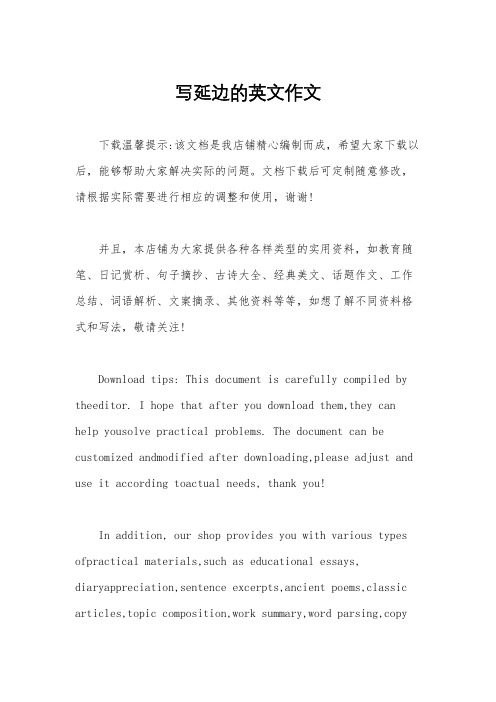
写延边的英文作文下载温馨提示:该文档是我店铺精心编制而成,希望大家下载以后,能够帮助大家解决实际的问题。
文档下载后可定制随意修改,请根据实际需要进行相应的调整和使用,谢谢!并且,本店铺为大家提供各种各样类型的实用资料,如教育随笔、日记赏析、句子摘抄、古诗大全、经典美文、话题作文、工作总结、词语解析、文案摘录、其他资料等等,如想了解不同资料格式和写法,敬请关注!Download tips: This document is carefully compiled by theeditor. I hope that after you download them,they can help yousolve practical problems. The document can be customized andmodified after downloading,please adjust and use it according toactual needs, thank you!In addition, our shop provides you with various types ofpractical materials,such as educational essays, diaryappreciation,sentence excerpts,ancient poems,classic articles,topic composition,work summary,word parsing,copyexcerpts,other materials and so on,want to know different data formats andwriting methods,please pay attention!In Yanbian, the food is amazing. There are all kinds of delicious Korean dishes. The kimchi is so spicy and flavorful.The scenery in Yanbian is really beautiful. You can see vast mountains and green forests. It's like a painting.The people in Yanbian are very friendly and warm-hearted. They always welcome visitors with big smiles.There are also many festivals and activities in Yanbian. It's so lively and interesting. You can experiencedifferent cultures.。
介绍延吉的英语作文结尾
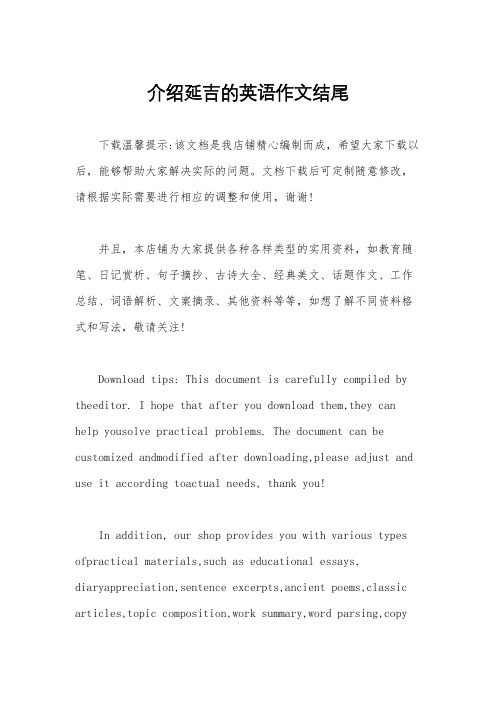
介绍延吉的英语作文结尾下载温馨提示:该文档是我店铺精心编制而成,希望大家下载以后,能够帮助大家解决实际的问题。
文档下载后可定制随意修改,请根据实际需要进行相应的调整和使用,谢谢!并且,本店铺为大家提供各种各样类型的实用资料,如教育随笔、日记赏析、句子摘抄、古诗大全、经典美文、话题作文、工作总结、词语解析、文案摘录、其他资料等等,如想了解不同资料格式和写法,敬请关注!Download tips: This document is carefully compiled by theeditor. I hope that after you download them,they can help yousolve practical problems. The document can be customized andmodified after downloading,please adjust and use it according toactual needs, thank you!In addition, our shop provides you with various types ofpractical materials,such as educational essays, diaryappreciation,sentence excerpts,ancient poems,classic articles,topic composition,work summary,word parsing,copyexcerpts,other materials and so on,want to know different data formats andwriting methods,please pay attention!In conclusion, Yanji is a city that offers a unique blend of culture, history, and natural beauty. The bustling streets, vibrant markets, and delicious local cuisine make it a delight for visitors. The city's rich history and diverse ethnic groups add to its charm and provide a fascinating glimpse into the past. Whether you are exploring the ancient temples, hiking in the picturesque mountains, or simply enjoying the local hospitality, Yanji has something to offer for everyone. So why not plan avisit to this hidden gem and experience the magic of Yanji for yourself?。
东北有什么风俗作文
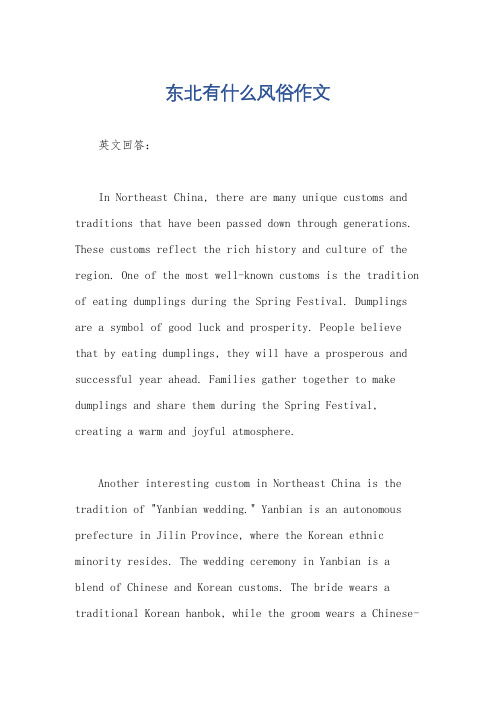
东北有什么风俗作文英文回答:In Northeast China, there are many unique customs and traditions that have been passed down through generations. These customs reflect the rich history and culture of the region. One of the most well-known customs is the tradition of eating dumplings during the Spring Festival. Dumplings are a symbol of good luck and prosperity. People believe that by eating dumplings, they will have a prosperous and successful year ahead. Families gather together to make dumplings and share them during the Spring Festival, creating a warm and joyful atmosphere.Another interesting custom in Northeast China is the tradition of "Yanbian wedding." Yanbian is an autonomous prefecture in Jilin Province, where the Korean ethnic minority resides. The wedding ceremony in Yanbian is a blend of Chinese and Korean customs. The bride wears a traditional Korean hanbok, while the groom wears a Chinese-style suit. During the ceremony, there are various rituals and performances, such as the "pyebaek" where the couple bows to their parents and receives their blessings. This unique blend of customs creates a special and memorable wedding experience.Furthermore, Northeast China is known for its winter festivals, such as the Harbin International Ice and Snow Sculpture Festival. This festival attracts millions of tourists from around the world every year. The festival features stunning ice and snow sculptures, ice lanterns,and various winter sports activities. It is a great opportunity for people to enjoy the beauty of winter and experience the unique culture of Northeast China.中文回答:在中国东北地区,有许多独特的风俗传统代代相传。
介绍朝鲜族英语作文
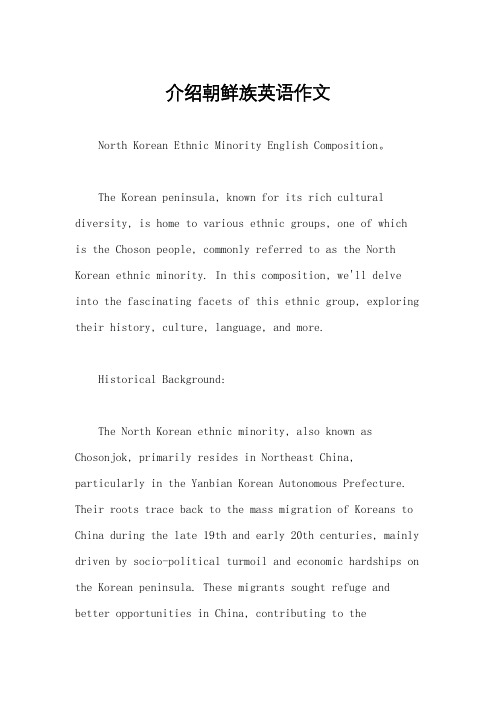
介绍朝鲜族英语作文North Korean Ethnic Minority English Composition。
The Korean peninsula, known for its rich cultural diversity, is home to various ethnic groups, one of whichis the Choson people, commonly referred to as the North Korean ethnic minority. In this composition, we'll delve into the fascinating facets of this ethnic group, exploring their history, culture, language, and more.Historical Background:The North Korean ethnic minority, also known as Chosonjok, primarily resides in Northeast China,particularly in the Yanbian Korean Autonomous Prefecture. Their roots trace back to the mass migration of Koreans to China during the late 19th and early 20th centuries, mainly driven by socio-political turmoil and economic hardships on the Korean peninsula. These migrants sought refuge and better opportunities in China, contributing to theformation of the Choson community.Cultural Heritage:The Choson people have preserved their Korean cultural identity while adapting to the Chinese way of life. They celebrate traditional Korean festivals such as Lunar New Year (Seollal) and Harvest Festival (Chuseok), wherefamilies gather to enjoy special meals, perform ancestral rituals, and engage in folk games and dances. Moreover,they maintain customs like hanbok (traditional Koreanattire) and have a rich repertoire of folk songs and dances, reflecting their deep-seated cultural roots.Language and Communication:Language serves as a crucial aspect of culturalidentity for the North Korean ethnic minority. While the majority of Choson people speak Korean, particularly the Hamgyong dialect, many are also fluent in Mandarin Chinese due to their integration into Chinese society. Thisbilingual proficiency allows them to navigate both Koreanand Chinese cultural spheres, fostering cross-cultural communication and understanding.Challenges and Opportunities:Despite their contributions to both Korean and Chinese societies, the Choson people face various challenges, including socioeconomic disparities, linguistic barriers, and occasional discrimination. However, they also have opportunities to preserve and promote their cultural heritage through educational initiatives, cultural exchanges, and community empowerment programs. Moreover, the growing global interest in Korean culture, known as Hallyu or the Korean Wave, provides a platform for the Choson people to showcase their unique cultural traditions to the world.Community Resilience:Despite facing adversities, the North Korean ethnic minority demonstrates remarkable resilience and solidarity as a community. They have established vibrant culturalcenters, schools, and organizations to preserve their heritage and support fellow Choson individuals. Additionally, they actively participate in cultural festivals, academic conferences, and diplomatic exchanges to promote intercultural dialogue and mutual understanding among diverse communities.Conclusion:In conclusion, the North Korean ethnic minority, or Chosonjok, represents a distinctive facet of the Korean diaspora, embodying a fusion of Korean and Chinese cultural elements. Their journey is a testament to the resilience of human spirit and the power of cultural heritage in shaping identity and fostering unity amidst diversity. As they continue to navigate the complexities of modern society, the Choson people remain steadfast in preserving their rich cultural legacy while embracing the opportunities of an interconnected world.This English composition provides insights into the unique characteristics and experiences of the North Koreanethnic minority, shedding light on their rich cultural heritage, linguistic diversity, and community resilience. Through understanding and appreciation, we can foster greater inclusivity and celebrate the diversity that enriches our global society.。
介绍延边景区作文英文
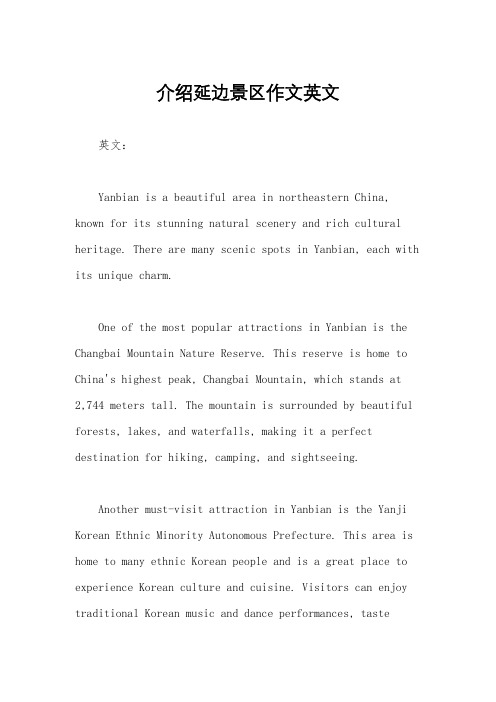
介绍延边景区作文英文英文:Yanbian is a beautiful area in northeastern China, known for its stunning natural scenery and rich cultural heritage. There are many scenic spots in Yanbian, each with its unique charm.One of the most popular attractions in Yanbian is the Changbai Mountain Nature Reserve. This reserve is home to China's highest peak, Changbai Mountain, which stands at 2,744 meters tall. The mountain is surrounded by beautiful forests, lakes, and waterfalls, making it a perfect destination for hiking, camping, and sightseeing.Another must-visit attraction in Yanbian is the Yanji Korean Ethnic Minority Autonomous Prefecture. This area is home to many ethnic Korean people and is a great place to experience Korean culture and cuisine. Visitors can enjoy traditional Korean music and dance performances, tastedelicious Korean food, and even try on traditional Korean clothing.Finally, the Yanbian International Korean Folklore Park is another popular destination for tourists. This park features traditional Korean architecture and houses, as well as beautiful gardens and scenic spots. Visitors can learn about Korean history and culture while enjoying the stunning scenery.Overall, Yanbian is a wonderful place to visit for anyone interested in nature, culture, and history. With so many beautiful and unique attractions, there is something for everyone to enjoy.中文:延边是中国东北地区一个美丽的地方,以其令人惊叹的自然景观和丰富的文化遗产而闻名。
朝鲜族纯英文介绍_带水印

MusicMain article: Music of KoreaPansoriPungmulApart from the instruments used, traditional Korean music is characterized by improvisation and the lack of breaks between movements. A pansori performance can last for over eight hours during which a single singer performs continuously.Rather than contrasting different speeds as it is common in Western music, most traditional Korean music begins with the slowest movement and then accelerates as the performance continues.Korean court music, called jeongak, is closely related to the literate upper-class, and has a strong intellectual emphasis. Jeongak is played at a very slow pace, with single beats taking as long as three seconds. The beat matches the speed of breathing rather than the heartbeat as in most Western music, and feels static and meditative.The tone of Jeongak is soft and tranquil because the traditional instruments are made of non-metallic materials. String instruments have strings made of silk rather than wire. Almost all wind instruments are made of bamboo. Pungmul is Korea's folk music and is full of expressions and emotions. This kind of traditional music is closely related to the lives of common people. As with the Jeongak, improvisation is common in Minsogak.Traditional Korean musical instruments can be divided into wind, string, and percussion types. Wind instruments include the piri (cylindrical oboe), taepyeongso (metal-bell shawm), daegeumsaenghwang (mouth organ) and the hun (ocarina). Traditional string instruments include zithers such as the gayageum, geomungo, and ajaeng, and the haegeum, a two-stringed fiddle.A great number of traditional percussion instruments are used including the kkwaenggwari (hand-held gong), the jing (hanging gong), buk (barrel drum), janggu, (hourglass drum), bak (clapper), and pyeonjong (bell chimes or stone chimes), as well as the eo (tiger-shaped scraper) and the chuk (wooden box).Main article: Korean danceJinju geommuAs with music, there is a distinction between court dances and folk dances. Common court dances are jeongjaemu performed at banquets, and ilmu, performed at Confucian rituals. Jeongjaemu is divided into native dances (hyangak jeongjae) and forms imported from China (dangak jeongjae). Ilmu are divided into civil dance (munmu) and military dance (mumu). Religious dances include all the performances at shamanistic rites (gut). Secular dances include both group dances and individual performances. Traditional choreography of court dances is reflected in many contemporary productions.Main article: Korean paintingA scenery on Dano dayThe earliest paintings found on the Korean peninsula are petroglyphs of prehistoric times. With the arrival of Buddhism from China, different techniques were introduced. These techniques quickly established themselves as the mainstream techniques, but indigenous techniques still survived.There is a tendency towards naturalism with subjects such as realistic landscapes, flowers and birds being particularly popular. Ink is the most common material used, and it is painted on mulberry paper or silk.In the 18th century indigenous techniques were advanced, particularly in calligraphy and seal engraving.Arts are both influenced by tradition and realism in North Korea. For example, Han’s near-photographic "Break Time at the Ironworks" shows muscular men dripping with sweat and drinking water from tin cups at a sweltering foundry. Son’s "Peak Chonnyo of Mount Kumgang" is a classical Korean landscape of towering cliffs shrouded by mists (source : "The New York Times", [5]. Sisters Duk Soon Fwhang and Chung Soon Fwang O'Dwyer who fled to the United States in the late 1950s avoid overtly political statements, and render seemingly benign subjects of nature—flowers, birds, fields, insects, mountains—as tempestuous and emotionally charged zones of conflict.Lacquer drawer with mother-of-pearl inlay, at the National Museum of Korea in Seoul.There is a unique set of handicrafts produced in Korea. Most of the handicrafts are created for a particular everyday use, often giving priority to the practical use rather than aesthetics. Traditionally, metal, wood, fabric, lacquerware, and earthenware were the main materials used, but later glass, leather or paper have sporadically been used.Ancient handicrafts, such as red and black pottery, share similarities with pottery of Chinese cultures along the Yellow River. The relics found of the Bronze Age, however, are distinctive and more elaborate.Many sophisticated and elaborate handicrafts have been excavated, including gilt crowns, patterned pottery, pots or ornaments. During the Goryeo period the use of bronze was advanced. Brass, that is copper with one third zinc, has been a particularly popular material. The dynasty, however, is renowned for its use of celadon ware.During the Joseon period popular handicrafts were made of porcelain and decorated with blue painting. Woodcraft was also advanced during that period. This led to more sophisticated pieces of furniture, including wardrobes, chests, tables or drawers.Main article: Korean pottery and porcelainA celadon incense burner from the Goryeo Dynasty with Korean kingfisher glaze.The use of earthenware on the Korean peninsula goes back to the Neolithic. The history of Korean Ceramics is long and includes both Korean pottery a later development after the traditional use of coils and hammered clay to create early votive and sculptural artifacts. During the Three Kingdoms period, pottery was advanced in Silla. The pottery was fired using a deoxidizing flame, which caused the distinctive blue grey celadon color. The surface was embossed with various geometrical patterns.In the Goryeo period jade green celadon ware became more popular. In the 12th century sophisticated methods of inlaying were invented, allowing more elaborate decorations in different colours.White porcelain became popular in the 15th century. It soon overtook celadon ware. White porcelain was commonly painted or decorated with copper. With the Japanese invasions of Korea in the 16th century, many potters were kidnapped to Japan where they profoundly influenced Japanese ceramics.[4] [5] [6] Many leading Japanese pottery families today can trace their art and ancestry to these Korean potters whom the Japanese kidnapped by the thousands, such as during the Japanese Assault on Korea of 1592.[6][7][8] In the mid Joseon period (late 17th century) blue-and-white porcelainbecame popular. Designs were painted in cobalt blue on white porcelain. With the growth of Japan's hegemony on the peninsula towards the end of the 19th century the tradition of porcelain largely declined in favour of Japanese imports. However, the fact that Japan's relocating whole cities of Korean potters by force to boost pottery culture in Japan annuls the misconception that the Japanese pottery culture flourished at the time.HomesMain article: Korean architectureTraditional house, hanokTraditional farmer's house; Folk Village, SeoulSites of residence are traditionally selected using geomancy. It is believed that any topographical configuration generates invisible forces of good or ill (gi). The negative and positive energies (yin and yang) must be brought into balance.A house should be built against a hill and face south to receive as much sunlight as possible. This orientation is still preferred in modern Korea. Geomancy also influences the shape of the building, the direction it faces and the material it is built of.Traditional Korean houses can be structured into an inner wing (anchae) and an outer wing (sarangchae). The individual layout largely depends on the region and the wealth of the family. Whereas aristocrats used the outer wing for receptions, poorer people kept cattle in the sarangchae. The wealthier a family, the larger the house. However, it was forbidden to any family except for the king to have a residence of more than 99 kan. A kan is the distance between two pillars used in traditional houses.The inner wing normally consisted of a living room, a kitchen and a wooden-floored central hall. More rooms may be attached to this. Poorerfarmers would not have any outer wing. Floor heating (ondol) has been used in Korea for centuries. The main building materials are wood, clay, tile, stone, and thatch. Because wood and clay were the most common materials used in the past not many old buildings have survived into present times. Japan's kidnapping of an entire city known for its castle building skills built Japan's most famous castles and palaces, an act which the Japanese government has formally accepted and apologized for.But now days, people live in apartments and more modernized houses.GardensMain article: Korean gardenHyangwonjeong, a garden in Gyeongbokgung, SeoulThe principles of temple gardens and private gardens are the same. They generally resemble gardens in China, and the Japanese in turn adopted a similar garden layout from Korea. Part of the reason is because gardening in East Asia is heavily influenced by Taoism. Taoism emphasizes nature and mystery, paying great attention to the details of the layout. In contrast to Japanese and Chinese gardens which fill a garden with man made elements, traditional Korean gardens avoid artificialities, trying to make a garden more natural than nature.The lotus pond is an important feature in the Korean garden. If there is a natural stream, often a pavilion is built next to it, allowing the pleasure of watching the water. Terraced flower beds are a common feature in traditional Korean gardens.The Poseokjeong site near Gyeongju was built in the Silla period. It highlights the importance of water in traditional Korean gardens. The garden of Poseokjeong features an abalone-shaped watercourse. During the last days of the Silla kingdom, the king's guests would sit along the watercourse and chat while wine cups were floated during banquets.DressMain article: HanbokHanbokHwarot, bridal robeSee also List of Korean clothing. The traditional dress known as hanbok (한복, 韩服) (known as joseonot in the DPRK) has been worn since ancient times. The hanbok consists of a shirt (jeogori) and pants (baji). The traditional hat is called gwanmo and special meaning is attached to this piece of clothing.According to social status, Koreans used to dress differently, making clothing an important mark of social rank. Impressive, but sometimes cumbersome, costumes were worn by the ruling class and the royal family. Jewelry was also used to distance themselves from the ordinary people. Traditional jewelry for women was a pendant shaped in the shape of certain elements of nature made of precious gems stones, to which a tassel of silk was connected. Common people were often restricted to un-dyed plain clothes. This everyday dress underwent relatively few changes during the Joseon period. The basic everyday dress was shared by everyone, but distinctions were drawn in official and ceremonial clothes.During the winter people wore cotton-wadded dresses. Fur was also common. Because ordinary people normally wore pure white undyed materials, the people were sometimes referred to as the white-clad people.Hanbok are classified according to their purposes: everyday dress, ceremonial dress and special dress. Ceremonial dresses are worn on formal occasions, including a child's first birthday (doljanchi), a wedding or a funeral. Special dresses are made for purposes such as shamans, officials.Today the hanbok is still worn during formal occasions. The everyday use of the dress, however, has been lost. However, elderly still dress in hanbok as well as active estates of the remnant of aristocratic families from the Chosun Dynasty.。
延边美食介绍英语作文
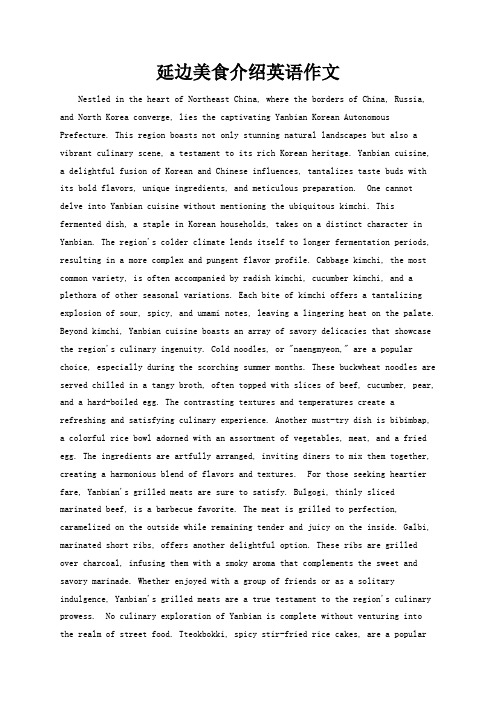
延边美食介绍英语作文Nestled in the heart of Northeast China, where the borders of China, Russia, and North Korea converge, lies the captivating Yanbian Korean Autonomous Prefecture. This region boasts not only stunning natural landscapes but also a vibrant culinary scene, a testament to its rich Korean heritage. Yanbian cuisine,a delightful fusion of Korean and Chinese influences, tantalizes taste buds withits bold flavors, unique ingredients, and meticulous preparation. One cannotdelve into Yanbian cuisine without mentioning the ubiquitous kimchi. This fermented dish, a staple in Korean households, takes on a distinct character in Yanbian. The region's colder climate lends itself to longer fermentation periods, resulting in a more complex and pungent flavor profile. Cabbage kimchi, the most common variety, is often accompanied by radish kimchi, cucumber kimchi, and a plethora of other seasonal variations. Each bite of kimchi offers a tantalizing explosion of sour, spicy, and umami notes, leaving a lingering heat on the palate. Beyond kimchi, Yanbian cuisine boasts an array of savory delicacies that showcase the region's culinary ingenuity. Cold noodles, or "naengmyeon," are a popular choice, especially during the scorching summer months. These buckwheat noodles are served chilled in a tangy broth, often topped with slices of beef, cucumber, pear, and a hard-boiled egg. The contrasting textures and temperatures create a refreshing and satisfying culinary experience. Another must-try dish is bibimbap,a colorful rice bowl adorned with an assortment of vegetables, meat, and a fried egg. The ingredients are artfully arranged, inviting diners to mix them together, creating a harmonious blend of flavors and textures. For those seeking heartier fare, Yanbian's grilled meats are sure to satisfy. Bulgogi, thinly sliced marinated beef, is a barbecue favorite. The meat is grilled to perfection, caramelized on the outside while remaining tender and juicy on the inside. Galbi, marinated short ribs, offers another delightful option. These ribs are grilledover charcoal, infusing them with a smoky aroma that complements the sweet and savory marinade. Whether enjoyed with a group of friends or as a solitary indulgence, Yanbian's grilled meats are a true testament to the region's culinary prowess. No culinary exploration of Yanbian is complete without venturing intothe realm of street food. Tteokbokki, spicy stir-fried rice cakes, are a popularstreet food snack. These chewy rice cakes are coated in a fiery gochujang sauce, offering a delightful combination of sweet, spicy, and savory flavors. Sundae, Korean blood sausage, is another street food delicacy that may surprise adventurous eaters. This sausage, made with a mixture of pig's blood, cellophane noodles, and barley, offers a unique and flavorful experience. Yanbian's culinary scene extends beyond savory dishes, with a delightful array of sweet treats to satisfy any sweet tooth. Hotteok, sweet pancakes filled with brown sugar, cinnamon, and nuts, are a popular street food dessert. These pancakes are cooked on agriddle until golden brown, creating a crispy exterior that gives way to a warm, gooey filling. Another sweet delight is patbingsu, a shaved ice dessert toppedwith red beans, condensed milk, and various fruits and toppings. This refreshing treat is perfect for cooling down on a hot summer day.。
朝鲜族简介英文版ppt

Traditional Men
男女服饰结构图
Food Culture
Koreans living in the coastal mountainous past, so in the diet, "delicacies", "seafood" account for a large proportion of play. Korean food can be divided into a routine and a special diet. Commonplace, including rice, soup, vegetables. Rice is an essential staple food of people three meals a day; soup is one of the essential meals, up to 30 kind of it. Daily generally prefer to drink miso soup, dog days likes to drink cold soup; lot of Korean cuisine types, two types of raw and
• The multi-sided wall plaster lath walls. Doors and windows for the push-pull, the same size as the door window, often regardless of the doors and can make the entrance.Window frames arranged in dense vertical, horizontal grid spacing away, along the narrow door window, making the already low room itself gives a
延边的民俗作文
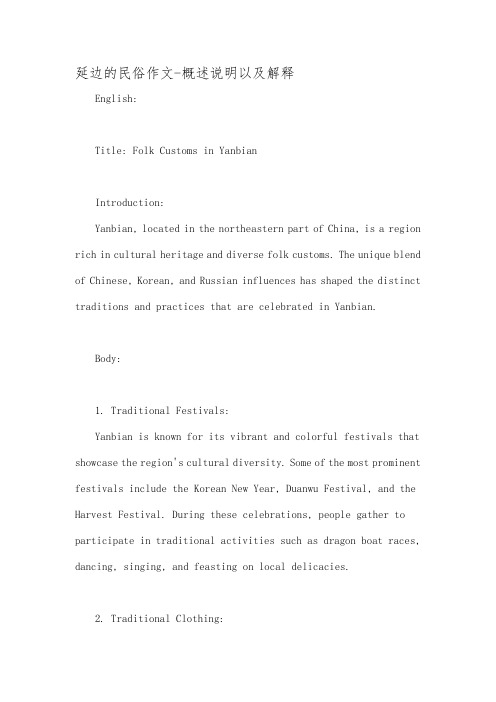
延边的民俗作文-概述说明以及解释English:Title: Folk Customs in YanbianIntroduction:Yanbian, located in the northeastern part of China, is a region rich in cultural heritage and diverse folk customs. The unique blend of Chinese, Korean, and Russian influences has shaped the distinct traditions and practices that are celebrated in Yanbian.Body:1. Traditional Festivals:Yanbian is known for its vibrant and colorful festivals that showcase the region's cultural diversity. Some of the most prominent festivals include the Korean New Year, Duanwu Festival, and the Harvest Festival. During these celebrations, people gather to participate in traditional activities such as dragon boat races, dancing, singing, and feasting on local delicacies.2. Traditional Clothing:The traditional clothing in Yanbian is a reflection of its multicultural heritage. The Korean hanbok, with its vibrant colors and intricate embroidery, is commonly worn during special occasions and festivals. In addition, the Russian-influenced fur hats and traditional Chinese attire can also be seen in the region.3. Traditional Cuisine:Yanbian boasts a wide range of traditional delicacies that tantalize the taste buds. Korean cuisine, such as kimchi, bibimbap, and bulgogi, is widely enjoyed by locals and visitors alike. Russian dishes like borscht and pelmeni have also found their place in the culinary scene of Yanbian. Additionally, traditional Chinese dishes like jiaozi and hotpot are popular choices for locals.4. Folk Performing Arts:Folk performances are an integral part of Yanbian's cultural identity. Traditional dances, music, and theatrical acts are showcased during various festivals and events. The Korean fan dance, Russian folk songs, and Chinese opera are just a few examples of the diverse performing arts that can be witnessed in Yanbian.Conclusion:Yanbian's rich cultural heritage is beautifully preserved through its folk customs. The region's unique blend of Chinese, Korean, and Russian influences has created a vibrant tapestry of traditions that continue to be celebrated and appreciated by both locals and visitors. Exploring the folk customs of Yanbian provides a fascinating insight into the region's history, culture, and identity.中文:标题:延边的民俗作文介绍:延边位于中国东北部,是一个文化遗产丰富、民俗多样的地区。
